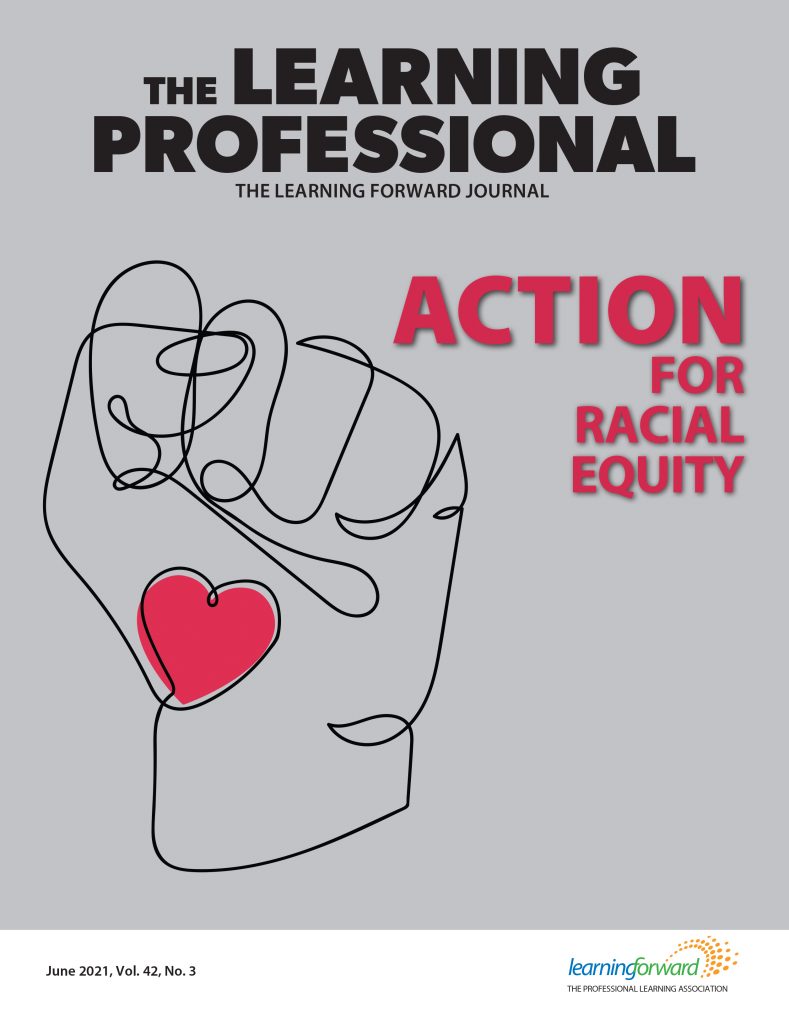
Action for racial equity
June 2021
Professional learning is an essential lever for achieving equity for all students. This issue focuses on actions educators can take to dismantle racism and help every student thrive, because changing beliefs is important but not enough. Articles examine professional learning and capacity building at all levels, including the classroom, school, district, and state.
Read the remaining content with membership access. Join or log in below to continue.
Sed ut perspiciatis unde omnis iste natus error sit voluptatem accusantium doloremque laudantium, totam rem aperiam, eaque ipsa quae ab illo inventore veritatis et quasi architecto beatae vitae dicta sunt explicabo. Nemo enim ipsam voluptatem quia voluptas sit aspernatur aut odit aut fugit, sed quia consequuntur magni dolores eos qui ratione voluptatem sequi nesciunt. Neque porro quisquam est, qui dolorem ipsum quia dolor sit amet, consectetur, adipisci velit, sed quia non numquam eius modi tempora incidunt ut labore et dolore magnam aliquam quaerat voluptatem.
In This Issue
FOCUS
Sparking dialogue that leads to action
To achieve equity, statements aren’t enough. This issue’s authors back them with action.
A path toward racial equity
Paving a way forward by reflecting on where we have been and where we need to go to embody the ideals we hold dear.
Black boys and policing: Rethinking the community helpers curriculum
Altering the community helpers unit in the early childhood curriculum is a start toward honoring Black boys’ potential.
4 practices for leaders to build equity
State leaders have a unique and important role to play in creating systemic equity.
Practical tools for improving equity and dismantling racism in schools
Cross-district networks leverage processes and tools to help school leaders take on challenging equity work.
Professional learning and equity directors work hand-in-hand
A partnership across departments leads the way toward antiracism in a Massachusetts district.
‘Let’s get ready to work even harder’ for Indigenous students
The pandemic gives us the chance to create schools students deserve, says Bureau of Indian Education program administrator.
The revolutionary act of teaching Black children superbly
The Center for Black Educator Development works to nurture Black and Brown teachers while developing literacy skills among children of color.
To dismantle racism, make teacher education more inclusive
A ‘deconstruct-reconstruct-construct’ approach can make the educator workforce more inclusive and just.
An educator’s guide to equity for Asian American and Pacific Islander people
Resources and tools challenge the “model minority” myth and encourage inclusion.
Student talk in science class leads the way to equity in Detroit
Teachers learn instructional practices to engage all students.
Reading list rewrite
The pursuit of equity reshapes the English curriculum in North Dakota district.
How educators can respond to anti-Asian racism: ONLINE EXCLUSIVE
Case studies illustrate overt and covert forms of anti-Asian racism and recommend actions to address and prevent them.
An artful approach to dialogue
A discussion guide to Byron Kim’s artwork “Synecdoche” can lead to student discussions about race and identity.
TOOLS
Equity tools and resources
Explore tools for examining equity practices, policies, and professional learning.
Through the lens
How this issue’s articles embody the Standards for Professional Learning.
RESEARCH
Data inform our progress toward equity
Recent publications help us understand where we are and how far we need to go to ensure opportunity for all students.
Data points
The latest on assistant principals, grow-your-own teacher programs, educator diversity, and teacher attrition.
VOICES





UPDATES
Recent Issues
NAVIGATING NEW ROLES
April 2025
Whether you’re new to your role or supporting others who are new, professional learning is essential for getting up to speed. This issue includes strategies and advice for a wide […]
LEARNING DESIGNS
February 2025
How we learn influences what we learn. This issue shares essential resources for creating, facilitating, and assessing high-quality professional learning.Read the remaining content with membership access. Join or log in […]
BUILDING BRIDGES
December 2024
Students benefit when educators bridge the continuum of professional learning between K-12 schools and other institutions. Read the remaining content with membership access. Join or log in below to continue. […]
CURRICULUM-BASED PROFESSIONAL LEARNING
October 2024
High-quality curriculum requires skilled educators to put it into practice. Professional learning can ensure instructional materials lead to excellent teaching and learning.Read the remaining content with membership access. Join or […]
























